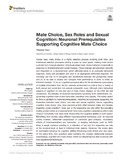Citation link:
http://dx.doi.org/10.25819/ubsi/10130Files in This Item:
| File | Description | Size | Format | |
|---|---|---|---|---|
| Fuss_Mate_choice_2.pdf | 438.88 kB | Adobe PDF |  View/Open |
| Dokument Type: | Article | metadata.dc.title: | Mate choice, sex roles and sexual cognition: neuronal prerequisites supporting cognitive mate choice | Authors: | Fuss, Theodora | Institute: | Institut für Biologie | Free keywords: | Plasticity, Personality, Neural integration, Brain size | Dewey Decimal Classification: | 590 Tiere (Zoologie) | GHBS-Clases: | VQW VOO |
Issue Date: | 2021 | Publish Date: | 2022 | Source: | Frontiers in Ecology and Evolution ; 9 (2021). - https://doi.org/10.3389/fevo.2021.749499 | Abstract: | Across taxa, mate choice is a highly selective process involving both intra- and intersexual selection processes aiming to pass on one’s genes, making mate choice a pivotal tool of sexual selection. Individuals adapt mate choice behavior dynamically in response to environmental and social changes. These changes are perceived sensorily and integrated on a neuronal level, which ultimately leads to an adequate behavioral response. Along with perception and prior to an appropriate behavioral response, the choosing sex has (1) to recognize and discriminate between the prospective mates and (2) to be able to assess and compare their performance in order to make an informed decision. To do so, cognitive processes allow for the simultaneous processing of multiple information from the (in-) animate environment as well as from a variety of both sexual and social (but non-sexual) conspecific cues. Although many behavioral aspects of cognition on one side and of mate choice displays on the other are well understood, the interplay of neuronal mechanisms governing both determinants, i.e., governing cognitive mate choice have been described only vaguely. This review aimed to throw a spotlight on neuronal prerequisites, networks and processes supporting the interaction between mate choice, sex roles and sexual cognition, hence, supporting cognitive mate choice. How does neuronal activity differ between males and females regarding social cognition? Does sex or the respective sex role within the prevailing mating system mirror at a neuronal level? How does cognitive competence affect mate choice? Conversely, how does mate choice affect the cognitive abilities of both sexes? Benefitting from studies using different neuroanatomical techniques such as neuronal activity markers, differential coexpression or candidate gene analyses, modulatory effects of neurotransmitters and hormones, or imaging techniques such as fMRI, there is ample evidence pointing to a reflection of sex and the respective sex role at the neuronal level, at least in individual brain regions. Moreover, this review aims to summarize evidence for cognitive abilities influencing mate choice and vice versa. At the same time, new questions arise centering the complex relationship between neurobiology, cognition and mate choice, which we will perhaps be able to answer with new experimental techniques. |
Description: | Finanziert aus dem Open-Access-Publikationsfonds der Universität Siegen für Zeitschriftenartikel |
DOI: | http://dx.doi.org/10.25819/ubsi/10130 | URN: | urn:nbn:de:hbz:467-22193 | URI: | https://dspace.ub.uni-siegen.de/handle/ubsi/2219 |
| Appears in Collections: | Geförderte Open-Access-Publikationen |
This item is protected by original copyright |
Page view(s)
360
checked on Dec 25, 2024
Download(s)
72
checked on Dec 25, 2024
Google ScholarTM
Check
Altmetric
Items in DSpace are protected by copyright, with all rights reserved, unless otherwise indicated.

